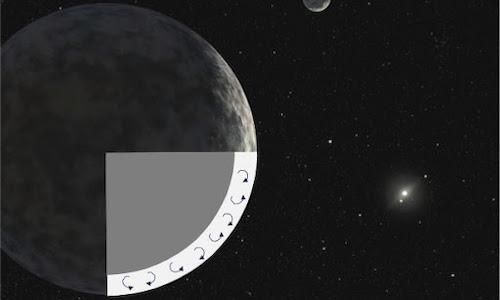University of California, Santa Cruz Professor of Planetary Sciences Francis Nimmo recently co-authored a Science Advances paper about the internal structure of the dwarf planet Eris.
Eris is about the size of Pluto but around 50% farther from the sun. The discovery of Eris in the Kuiper Belt beyond Neptune in 2005 prompted the debate that ultimately reclassified Pluto as a dwarf planet.
It was an interest in Pluto that drew UC Santa Cruz researcher Francis Nimmo to study Eris.
Nimmo was visiting Michael Brown — one of the discoverers of Eris — at the California Institute of Technology about six months ago and realized some of Brown’s new, unpublished data could help reveal information about the properties of Eris.
The two worked on models for the next several months and published their results in a Science Advances paper last week. Two main pieces of information led to their results.
The first important clue is that Eris and its moon, Dysnomia, always face the same way toward each other.
“That happens because the big planet gets spun down by the tides that the little moon raises on it,” explained Nimmo. “The bigger the moon is, the faster the planet spins down.”
Researchers can use the spin and orbital characteristics of planets and their moons to infer properties of their internal structures. But until recently, scientists did not have an estimate for the size of Dysnomia.
Brown’s then-unpublished data changed that by revealing that Eris’s moon must be below a certain mass. This upper limit on mass provided the second crucial piece of information.
“And so as soon as you know that, then you can actually start to do real calculations,” said Nimmo.
The main, unexpected result of Nimmo and Brown’s model is that Eris is surprisingly dissipative, or “squishy”.
The co-authors determined that Eris has a rocky core surrounded by a layer of ice. This outer shell of ice is likely convecting, unlike the conducting shell of Pluto.
“The rock contains radioactive elements, and those produce heat. And then that heat has to get out somehow,” explained Nimmo. “So as the heat escapes, it drives this slow churning in the ice.”
Eris therefore behaves less like a rigid object and “more like a soft cheese or something like that. It has a tendency to flow a bit,” said Nimmo.
Future Data
The upper limit on the mass of Dysnomia came from measurements made by the Atacama Large Millimeter Array (ALMA) radio telescope. Nimmo hopes that soon, more exact measurements of the mass will help further refine the model.
“If Dysnomia is smaller than that, then Eris is even more squishy,” he said.
Additional data about the shape of Eris will help verify the model Nimmo and Brown created.
“We make the point that Eris should be pretty smooth because if there’s any surface topography, the ice is going to flow and that topography will go away,” said Nimmo. “So it would be nice to get some measurements of what shape Eris is because if it’s very irregular, that would not agree with our model.”
Eris is so distant from Earth that it shows up as a single pixel, so in order to reconstruct its shape, scientists will need to watch the planet pass in front of stars.
“The star blinks out and then the star comes back, and that tells you how wide Eris is at that point. And if you do that with a whole bunch of stars, then you can actually reconstruct shape,” explained Nimmo. “I’m hoping people are actually doing it, I just don’t know whether they are.”



